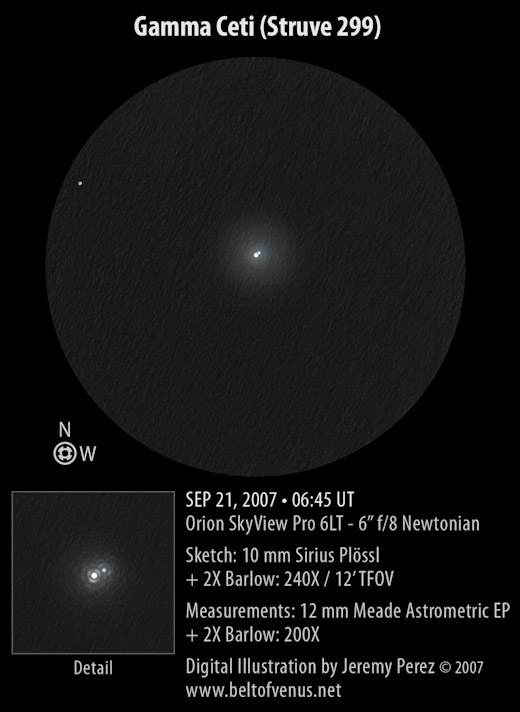
Click image for larger version
Observation Notes:
At the neck of the circlet of Cetus lies a close double star with a noticeable difference in magnitude. The primary star is about 9 times as bright as its companion and appeared white to me. Its spectral class of A2 agrees fairly well with this. Its fainter companion appeared to be a dull blue gray color, but according to the 13th General Catalogue of MK Spectral Classifications (Buscombe 1998), the secondary is an F3V star and definitely not blueish. My separation estimate was hindered by jumpy seeing, but I noted about 2 arc-seconds. The WDS measurement from 1825 was 2.7″ and the Hipparcos measurement from 1955 was 2.8″. I measured a PA of 299 degrees. The WDS PA from 1825 was 289 degrees, and the Hipparcos PA from 1955 was 194 degrees, so the PA I measured is probably fairly close to the current value.
So much for my research…Jeff Burton’s Astronomy Blog notes that the primary is yellow and the secondary blue. He also notes 2002 values of 2.3″ separation and 299 degrees PA. This is in much better agreement with my observation. I’ll need to dig into the resources he used to see where that data came from.
[edit – September 29, 2007]: I’m beginning to feel a little better about seeing the F-class secondary star as blue. In addition to Jeff Burton’s “yellow/blue” description, Astronomy Magazine’s Star Dome notes the pair as white/blue. Mimi.hu notes yellow/blue, Mark and Alison Kudlowski describe the pair as yellowish/whitish-lilac, Smyth and Flammarion described the double as pale yellow/blue, and Jim Kaler also acknowledges this description of yellow/blue, attributing it to our old double star buddy, “contrast effects”.
[edit – June 8, 2012]: Updated illustration to match current style.
| Subject | Gamma Ceti (STF 299) |
| Classification | Double Star |
| Position (J2000) | Cetus [RA: 02:43:18.04 / Dec: +03:14:09]* |
| Position Angle* | 299° [my measurement] 298°[2006 WDS] 283° [1825 WDS] |
| Separation* | 2″ [my measurement] 2.3″ [2006 WDS] 2.8″ [1825 WDS] |
| Magnitudes* | 3.6 / 7.4 |
| Spectral Types* | A2V / F3V |
| Date/Time | SEP 20, 2007 – 11:45 PM MST (SEP 21, 2007 – 06:45 UT) |
| Observing Loc. | Flagstaff, AZ – Home |
| Instrument | Orion SVP 6LT Reflector (150 mm dia./1200 mm F/L) |
| Eyepieces/Mag. | 10 mm Sirius Plössl + 2X Barlow (240X) 12 mm Meade Astrometric EP + 2X Barlow (200X) |
| Conditions | Breezy, 1st quarter moon, patchy cirrus |
| Seeing | 5/10 Pickering |
| Transparency | NELM Mag ~5.0 |
| *References | The Washington Visual Double Star Catalog, 1996.0 (Worley+, 1996); Catalogue of Stellar Spectral Classifications (Skiff, 2005); 13th General Catalogue of MK Spectral Classification (Buscombe 1998); Visual Double Stars in Hipparcos (Dommanget+, 2000); Starry Night Pro Plus 5.8 |
Jeremy, I noticed a discrepancy between the PA in your Observation notes (199 deg)and the PA for your measurement in your table (299 deg). I gather the WDS is out of date based on the other observations.
Markstar, thanks for catching those typos! 299 degrees is what I meant to type in the discussion text. I thought it was interesting to include the WDS measurement from 1825 to demonstrate the change in PA over the course of ~185 years. I’ve updated the details in the table to also include the WDS 2006 info (PA 298° / Sep 2.3″).